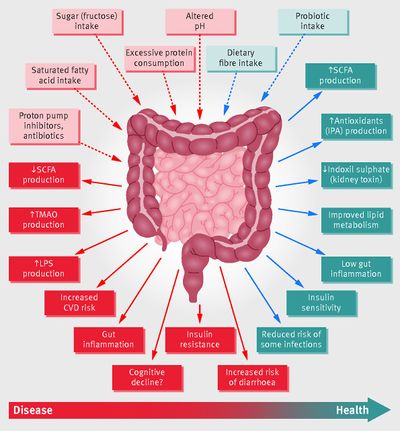The Human Gut: Difference between revisions
Nhutran2021 (talk | contribs) No edit summary |
Nhutran2021 (talk | contribs) |
||
| Line 4: | Line 4: | ||
<br>The human gut, also known as the gastrointestinal (GI) tract, consisting of all the organs that allow for humans to consume, digest, and expel food, and is highly populated by a diverse range of microbiota that serves many crucial processes in maintaining human health, such as digestion, fighting infection, and production of key vitamins and antioxidants. The microbes occupying the gut ranges to the order of 10<sup>17</sup> and consists primarily of bacteria, but also includes a variety of protozoa, archaea, prokaryotes, and viruses.<br> | <br>The human gut, also known as the gastrointestinal (GI) tract, consisting of all the organs that allow for humans to consume, digest, and expel food, and is highly populated by a diverse range of microbiota that serves many crucial processes in maintaining human health, such as digestion, fighting infection, and production of key vitamins and antioxidants. The microbes occupying the gut ranges to the order of 10<sup>17</sup> and consists primarily of bacteria, but also includes a variety of protozoa, archaea, prokaryotes, and viruses.<br> | ||
==Detailed Environmental Description== | ==Detailed Environmental Description== | ||
Revision as of 08:37, 4 June 2020
Overview
By Mia Tran
The human gut, also known as the gastrointestinal (GI) tract, consisting of all the organs that allow for humans to consume, digest, and expel food, and is highly populated by a diverse range of microbiota that serves many crucial processes in maintaining human health, such as digestion, fighting infection, and production of key vitamins and antioxidants. The microbes occupying the gut ranges to the order of 1017 and consists primarily of bacteria, but also includes a variety of protozoa, archaea, prokaryotes, and viruses.
Detailed Environmental Description
Describe the physical and geochemical environment that you are reporting on. How well is has this been studied? Is it current or is most of the work from the 80s? What are the geochemical characteristics? Include some current research, with at least one figure showing data.
Every point of information REQUIRES CITATION using the citation tool shown above.
Overview of Microbial Ecology as it is known
Discuss the alpha and beta diversity of the system. Include some current research, with at least one figure showing data.
Expansion topic 1-3
How you expand upon the basics will depend on your environment. Pick a couple or three of interesting subtopics and describe them in detail. Include some current research, with at least one figure showing data.
Key Microbial Players
In all of your systems there will be at least a couple of key microbial players. Describe these in detail. Where do they fall on the tree of life? Are they cultured? What do they do in general and as it relates to your target environment?
Conclusion
References
Authored for Earth 373 Microbial Ecology, taught by Magdalena Osburn, 2020, NU Earth Page.

